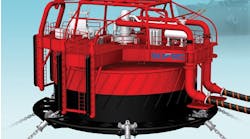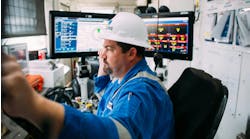MARINE CONSTRUCTION Pipe purging for welding of alloys, stainless steels
Water soluble films can be used for welding environments
Ron Sewell
Huntingdon Fusion Techniques
When stainless steel pipes and tubes, hereafter referred to only as pipes, (and some made of other materials such as chrome moly carbon steel, copper nickel, titanium, etc) are welded together or to fittings, it is desirable to purge the oxygen out of the inside of the material near the weld zone to prevent it from reacting with the hot metal and causing coking, porosity, uneven penetration and others.
Mostly, argon is used for purging because it is an inert gas and because it is readily available for welding. In some countries, it is customary to use nitrogen for some of this work, although it cannot be universally applied for purging. For example, nitrogen can combine with hot titanium to cause undesirable nitrides of the parent metal.
To obtain a quality purge is not easy. It has been customary to fill the pipe assembly with gas and keep the gas running at what is thought to be a suitable flow rate for an estimated period of time. In today's climate of ever improving quality control and increasing demands on procedures with traceability, it is inappropriate to use such hit and miss methods to guarantee a satisfactory purge.
Avoiding gas purge
Clearly it is not desirable to simply pour gas into a pipe assembly in the hope that a good purge will be achieved. The principle disadvantage of this is that it will cost the operator more money than is necessary, particularly for larger diameter and longer length assemblies. In addition, the time taken to remove all of the oxygen causes lengthy waiting periods by costly specialists. Furthermore, there is no guarantee that such voluminous quantities of gas and protracted purging periods will actually prevent a bad weld.
When confronted with large volumes to purge, the specialist will attempt to confine the volume by damming the pipe in some way. Many specialists still use poor quality materials to dam pipes. Cloth, wooden discs, and foam bungs are all common. Such materials generally have a high vapour pressure and can emit contaminating vapors into the space being purged. Clearly, it is better to use specialist products which are made for the purpose of pipe purging.
Some of the specialist products available include purge bladders, solid rubber disc purge dam assemblies, and water soluble materials for users to manufacture their own dams. Bladders and rubber disc assemblies require an open end to enable the assembly to be retrieved after the weld is finished. Dams made from water soluble materials can be used for open assemblies and closing welds.
Water soluble materials are available in both plastic and paper forms. The paper product may leave relatively large fibers after dissolving. They can cause filters to become blocked. Furthermore, paper is becoming increasingly expensive and ecologically undesirable so the water soluble plastic would seem to be the purging product of the future.
Soluble plastic films
A British-made water soluble plastic is available for the purpose of making dams for the purging of pipe welds. This is made from a evon (polyvinyl alcohol) film at a thickness of 35 microns. This material is truly biodegradable and analysis by infrared spectrometry shows the absolute minimum of residual inorganic products after dissolving in water. This material has been approved by the American FDA for the wrapping of foodstuffs.
The material is provided on a cardboard former just over 20 in. long and it is double folded so that the 39-in. (1 meter) width is reduced to a manageable size. The material length is 65 ft giving adequate quantities for a large number of dams to be made.
The material can be rolled out onto a work table and a disc with a diameter of 2 in. or so larger than the pipe to be purged, can be cut. For pipe diameters of less than 20 inches, one cut will give two dams.
A cardboard former just a little bit smaller than the pipe diameter can be cut and used to place of the dams inside the open pipe end. The pipe ends will have been cleaned beforehand to be free from dirt or grease, and some of the water soluble adhesive wiped around the inside of the pipe where the dam is to be situated. The cardboard former helps guide the dam into place and the excess material can be stuck down on the previously applied adhesive.
Once one of these dams has been placed either side of the joint line, the assembly can be moved together and clamped or tacked ready for welding. The butt will be taped to prevent escape of gas and holes will be made as appropriate to feed argon gas into the innerspace and to release air and excess argon.
Because argon is heavier than air, it is best to arrange for the gas to enter the purge cavity at the bottom at a flow rate of 10 liters/minute or less to avoid turbulence and prevent the argon mixing with the air. The gas exit hole should be at the top of the innerspace to ensure that the whole cavity is filled with argon and all oxygen removed.
As the weld draws to its end, the gas flow will be reduced to a minimum to prevent the molten weld root from being blown outwards. For absolute certainty that the oxygen level has been reduced to an acceptable content, usually 1% or less for stainless steel welding, it is advisable to connect a purge monitor to the exhaust area. This will ensure that time and gas are not wasted by arbitrary selection of purging times.
After welding, once the material has cooled sufficiently and the purge gas hoses withdrawn, the dams can be washed away with water. In some cases the pipework will be hydrostatically tested, which involves filling it up with water. In other cases, the pipework will need to be washed out prior to use to ensure that all contaminating materials are removed. While the PVOH material dissolves readily in hot water or steam.
This British made water soluble plastic has already been used widely throughout the world on major welding projects, including nuclear reactors. Other users include dairies, food manufacturing facilities, shipyards, refineries, oil production platforms, breweries, chemical plants and others. This means that the welder has a new low cost easy way to use material for any stainless steel weld whether it be for new plant or repair, or maintenance and extension of existing ones.
Copyright 1996 Offshore. All Rights Reserved.


